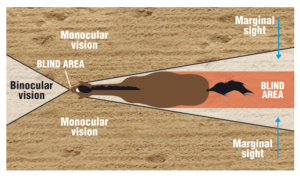History
When we look at horses today some of us would never guess that horses were once much smaller. The modern horse is descended from a small dog-like animal called Hyracotherium (Also known as Eohippus)

. Over time these horses evolved into the modern horse we see today, but not before going through some major evolutionary changes. Ancient horses had not one toe, but 4 toes. These toes evolved into splint bones on the modern horse. Horses also evolved from being around 2 feet tall to 5 feet tall.
Characteristics
During their evolution, they also developed some unique characteristics and behaviors that shaped them into our modern society. Horses are herbivores with special diet requirements. Unlike cattle, horses have a simple stomach like a human. The digestive tract of the horse is almost 100 feet long, but the organs hold small amounts of food. Because of this, horses do well with eating small amounts throughout the day.
Behavior
On the predator and prey scale, horses definitely fall under the prey category. Horses are hard programmed with a flight response when faced with a threat. They also band together in groups, which is a characteristic common in prey animals. This trait has evolved over many years, and horses can have trouble being separated from their groups even today. Despite their large size, horses can still travel quickly. Their skeleton has evolved to enhance their running ability. The shoulder is not anchored in a socket, which allows for greater mobility.
Vision
A grazing horse can see almost all the way around its body because of the placement of the eyes on the side of the head. The horse has three different “types” of vision.

Binocular Vision: vision using two eyes with overlapping fields of view, allowing good perception of depth.
Monocular Vision: vision in which both eyes are used separately.
Marginal Sight: this is the area that is right along the border of the horses blind spot.
Uses
Horses were traditionally used for many purposes. People have used horses for warfare, farming practice, food, transportation, and pleasure. Horses back in the day served a different purpose than the modern day horse. There are still people that use horses for food or work purposes. With the industrial revolution, the horse made a shift from work animal, to pleasure animal. Today horses are competing in lots of different events from cow cutting to racing. Many of these events have roots back to the early days of the domesticated horse. The next time you see someone with a horse, don’t be afraid to go up and ask them about the history of that animal, you might find something you don’t know.